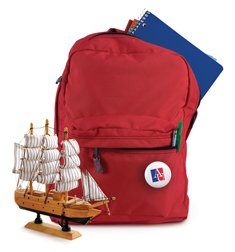
Even though the Asia-Pacific region comprises almost one-third of the globe, it’s historically been neglected by most college history departments. “It will make a cameo appearance in an important part of other stories,” CAS professor Justin Jacobs says. But in his fall course about British explorer and cartographer Captain James Cook—offered for the first time this semester as part of the AU Core Curriculum, which fosters curiosity and agile thinking to prepare students to tackle the complexities of a changing world—the region plays a starring role.
Between 1768 and 1779, Cook made three yearslong voyages across the largely uncharted waters of the Pacific, becoming the first European to encounter the eastern coast of Australia and the Hawaiian Islands and navigate the high latitudes of the Arctic and Antarctic circles. For two centuries, Cook has been viewed as “a great man of history, as valorized [by England] as George Washington is by the US,” Jacobs says. And even amid more careful scrutiny in recent years, as historians consider the legacy of colonialism, “Cook, generally speaking, comes off pretty well.”
“When you dig into his diaries, there are a few times when he engages in violence, but compared to his contemporaries, like the Spanish conquistadors, he’s a fairly enlightened explorer,” says Jacobs, whose research focuses on China, Xinjiang, the Silk Road, antiquities, and archaeology.
The class strives to understand the perspective and agency of Native peoples throughout the Pacific, their histories and cultures before Cook, the impact of his arrival, and what happened to them after he and his crew left. Jacobs also examines political alliances, trade, sex and disease, and kidnapping and slavery; competing systems of property rights; perceptions of savagery and paradise; the high drama of first encounters; and the modern-day legacies of Cook's expeditions.
The class draws on myriad resources, including Tony Horwitz's Blue Latitudes: Boldly Going Where Captain Cook Has Gone Before; films like the 1984 British historical drama, The Bounty; and Cook's own extensive diaries. Assignments include a map quiz, which challenges students to do what most Americans can't: identify Tonga, Tahiti, Easter Island, the Great Barrier Reef, the Bering Strait, and more among a vast swath of blue ocean.
The course culminates with an “alien contact diary” in which students—through eight 150-word entires—imagine "a band of powerful, resourceful, and mysterious" extraterrestrials, far superior to indigenous Earthlings in material culture and more capable of inflicting physical harm and destruction, landing on our planet.
“That,” Jacobs says, “is the only analogy for what it was like for Native peoples across the Pacific to suddenly encounter these strange White men on massive wooden ships."